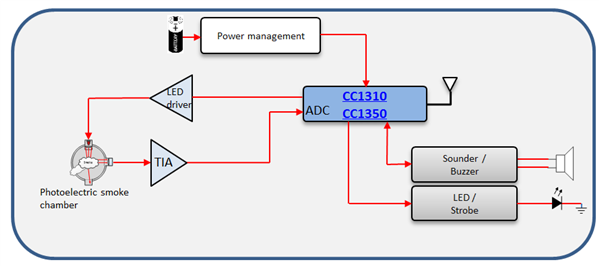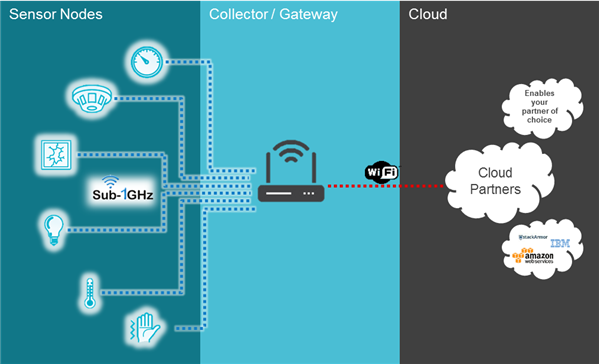SSZTA11 july 2017 CC1310 , CC1350
Smoke alarms are critical devices used universally to help detect fires and save lives. They sense smoke and assist in building evacuations using sirens. Traditionally, smoke alarms are wired systems; however, wireless connected smoke alarms are becoming more common and wireless smoke alarms simplify installation/maintenance and reduce cost compared to wired smoke alarms. However, the wireless smoke alarm design introduces challenges of power consumption, wireless networking for whole building coverage, and security due to the vulnerability of connected networks. By using TI’s SimpleLink™ Sub-1 GHz CC1310 and dual-band CC1350 wireless microcontrollers (MCU’s), you can address these design challenges to easily create a wireless smoke alarm design.
Common System Requirements
When designing a wireless smoke alarm one of the most common system requirements is a long battery life. The MCU shutdown and standby currents are low (0.185µA/0.7µA respectively) and the CC13xx devices have a low MIPS/MHz (51µA/MHz) current consumption, making computation and housekeeping activities efficient and stabilized. Finally, the RX mode (5.4mA) and TX mode (13.4mA at 10dbm) along with fast transition times reduces the overall current consumption. Moreover, the CC1310 and CC1350 wireless MCUs contain a sensor controller, a proprietary MCU core that allows the rest of the system to sleep while waiting for an external event trigger. This enables the wireless smoke alarm to run for at least 10 years on a coin cell battery. Figure 1 indicates the profile of a typical panel-connected fire alarm system.
 Figure 1 Illustrated Power Profile for a Wireless Smoke Alarm
Figure 1 Illustrated Power Profile for a Wireless Smoke AlarmAnother requirement for a smoke alarm system is to have secure and robust transmissions. Therefore, it is important to have a complete software stack with added security features to help protect the transmission. For example, the SimpleLink Sub-1 GHz wireless MCUs are supported by the CC13x0 software development kit (SDK) which contains the star networking TI 15.4-Stack based on the 802.15.4g standard and includes both frequency hopping and added security features. The TI 15.4-Stack uses an advanced CSMA/CA networking algorithm, implementing a “listen before talk” mechanism to minimize the amount of collisions, resulting in a robust network. Furthermore, Sub-1 GHz frequency bands propagate well in the air, through walls, and around corners allowing for full coverage of large buildings and office spaces.
Additionally, TI’s dual-band CC1350 device supports both Sub-1 GHz and Bluetooth® low energy in a single chip which allows for a scalable system. The addition of Bluetooth low energy to safety systems, particularly smoke alarms, enhances the user experience by adding a native interface to the smoke alarm units. Using a smartphone application, users can receive status updates, transmit network properties, and push software updates over a Bluetooth low energy connection. Bluetooth low energy beacons also allow smoke alarms to transmit broadcast messages to a nearby smartphone.
Designing a System with a SimpleLink Sub-1 GHz Wireless MCU
When designing a wireless smoke alarm, users can connect the smoke sensor to the MCU’s analog-to-digital converter (ADC) through an amplifier that converts current to voltage, or it can be connected to a comparator and trigger the MCU using an interrupt. The CC1310/CC1350 devices have a large number of general-purpose input/output (GPIO), inter-integrated circuit (I2C), universal asynchronous receiver/transmitter (UART), serial peripheral interface (SPI) and other interfaces that may be required. By choosing a wireless MCU versus an MCU plus a radio-frequency (RF) transceiver chip combination, the system can achieve lower power size, and lower cost allowing for a quicker time to market. Figure 2 shows the block diagram of a typical smoke alarm system.
 Figure 2 Photoelectric Smoke Alarm System Block Diagram
Figure 2 Photoelectric Smoke Alarm System Block DiagramCloud Connectivity
Security and safety systems can also benefit from cloud connectivity because the cloud gives users the ability to monitor and control systems remotely. However, Sub-1 GHz requires a gateway in order to connect to the internet, which buffers and translates messages from the Sub-1 GHz network into Ethernet packets and communicates with the cloud over Ethernet or Wi-Fi®. TI’s Sub-1 GHz Sensor to Cloud Industrial IoT Gateway Reference Design provides an end-to-end system based on cloud connectivity to send and receive sensor data over a long-range Sub-1 GHz network (Figure 3). Some features included in the reference design are advanced encryption standard (AES)-128, message integrity codes, frequency hopping, and cloud integration.
 Figure 3 Sensor to Cloud General Block Diagram
Figure 3 Sensor to Cloud General Block DiagramConclusion
Wireless smoke alarms introduce new design challenges including long-range coverage, good battery life, security, robustness, and scalability. SimpleLink Sub-1 GHz CC1310 and dual-band CC1350 wireless MCUs address these design problems by offering whole-building coverage, 10-year operation on a coin cell battery, complete software with built-in security, and an end-to-end gateway solution. This makes designing a wireless smoke alarm easier and enables developers to have lower costs and a quicker time to market than wired smoke alarm designs.
Additional Resources
- Learn more about wireless smoke alarms in the application report, “Wireless Smoke Alarms with Sub-1 GHz SimpleLink™ Wireless MCU.”
- Download these other reference designs:
- Fire & Carbon Monoxide Alarm Detector Reference Design with Low BOM Cost & Integrated Battery Backup.
- Energy Harvesting Ambient Light and Environment Sensor Node for Sub-1GHz Networks Reference Design.
- Humidity and Temperature Sensor Node for Sub-1 GHz Star Networks Enabling 10+ Year Coin Cell Battery Life.
- Read the blog post, “How to build a fully managed and scalable long-range network with low-power nodes.”
- Check out the white paper, “Bringing wireless scalability to intelligent sensing applications.”
- Visit our smoke and heat detector page for even more resources.